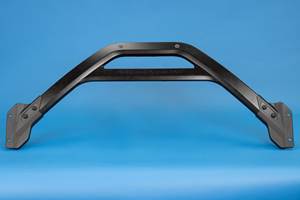Biggest hurdles for automotive composites
Patrick Blanchard, global technical leader – composites at Ford Motor Co., discussed at SPE ACCE three major hurdles composite materials face.
I attended the 2017 SPE Automotive Composites Conference and Exhibition (ACCE) in September, in Novi, MI, US. This event is, arguably, the composites industry’s authoritative go-to conference for the latest on materials, processes and emerging technologies for automotive manufacturing. It draws OEMs and suppliers alike.
As you might expect, the presentations focused on materials, processes and techniques that have helped simplify and streamline the integration of composite materials into high-volume automotive manufacturing: Snap-cure thermoset resins, thermoplastic composites, high-pressure resin transfer molding (HP-RTM), compression molding, design optimization, sheet molding compound (SMC), recycling, automation for high-speed/high-volume manufacturing, long fiber processes and more.
Perhaps the most revelatory presentation at the 2017 edition of ACCE came from Patrick Blanchard, global technical leader – composites, at Ford Motor Co., who gave a keynote speech on the third day of the conference. He discussed, among other things, the biggest hurdles to integrating composites into high-volume manufacturing. As an example, he pointed to a carbon fiber B-pillar insert demonstrator developed by Ford, Dow and Continental Structural Plastics to evaluate design, manufacturing and assembly challenges. This work highlighted for Blanchard three major hurdles composite materials face. His comments on each:
1) Design optimization. The composites design process — compared to steel, aluminum and unreinforced plastics — is highly protracted due to the number of degrees of freedom offered by composites (resin/fiber combinations) and the absence of robust and reliable automated optimization tools. Simplified tools are needed to reduce the lead time for design iteration.
2) Forming simulation. Kinematic drape models are only suited to a first-order approximation and do not capture critical forming constraints. Finite element models incorporating contact demonstrate better correlation, but extensive validation is required.
3) Assembly. How does an OEM insert a part or structure into the assembly process? Adoption of composites in body-in-white (BIW) solutions will require joining and assembly methods that can tolerate mixed-material joints. The transition from welding processes to a combination of bonding and/or mechanical fasteners may be required.
I asked Blanchard which of the three is most onerous or of concern to him. Most problematic, he said, is #1 — design optimization. At Ford, he explained, vehicle design and development includes specific and limited time windows for the design and optimization of each part, leading to implementation. The performance data associated with steel, aluminum and plastics allow quick development of parts made with these materials. Composites, conversely, lack those robust performance data, and, thus, are more difficult to move through the design cycle. In short, automotive OEMs can’t afford the time it takes to design a composite part well.
For more from Blanchard, take a listen to my talk with him on Episode 10 of CW Talks: The Composites Podcast.
This is not a new problem, and probably solvable if the slate of resins, fibers and manufacturing processes used in automotive manufacturing were well established and understood. But they are not, mainly because material suppliers are still busy optimizing resins and fibers, and machinery suppliers are busy evolving manufacturing technologies. Which is great, because optimization is needed. But the result is, as usual, an innovation-driven, highly dynamic, rapidly evolving manufacturing landscape that is difficult to codify, model and simulate.
Still, the CAE software suppliers serving the composites industry are keenly aware of the challenge their customers face, and I expect we will see, in the next several years, substantial improvement in the speed and accuracy of design and simulation tools. Certainly, all of us are highly motivated to do what we can to make composites easy to use, apply and manufacture.
Related Content
Thermoplastic composites: Cracking the horizontal body panel nut
Versatile sandwich panel technology solves decades-long exterior automotive challenge.
Read MoreAutomotive chassis components lighten up with composites
Composite and hybrid components reduce mass, increase functionality on electric and conventional passenger vehicles.
Read MoreInfinite Composites: Type V tanks for space, hydrogen, automotive and more
After a decade of proving its linerless, weight-saving composite tanks with NASA and more than 30 aerospace companies, this CryoSphere pioneer is scaling for growth in commercial space and sustainable transportation on Earth.
Read MorePlant tour: Joby Aviation, Marina, Calif., U.S.
As the advanced air mobility market begins to take shape, market leader Joby Aviation works to industrialize composites manufacturing for its first-generation, composites-intensive, all-electric air taxi.
Read MoreRead Next
Plant tour: Daher Shap’in TechCenter and composites production plant, Saint-Aignan-de-Grandlieu, France
Co-located R&D and production advance OOA thermosets, thermoplastics, welding, recycling and digital technologies for faster processing and certification of lighter, more sustainable composites.
Read MoreAll-recycled, needle-punched nonwoven CFRP slashes carbon footprint of Formula 2 seat
Dallara and Tenowo collaborate to produce a race-ready Formula 2 seat using recycled carbon fiber, reducing CO2 emissions by 97.5% compared to virgin materials.
Read MoreDeveloping bonded composite repair for ships, offshore units
Bureau Veritas and industry partners issue guidelines and pave the way for certification via StrengthBond Offshore project.
Read More









.jpg;maxWidth=300;quality=90)












